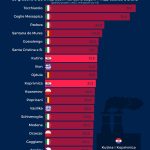After 2020, which will be remembered for efforts to curb the COVID-19 pandemic and for the devastating quakes that hit the capital city of Zagreb on 22 March and Sisak-Moslavina County on 28 and 29 December, the outgoing year has been marked by a high growth rate.
In 2020, the economy contracted by 8% and it is set to have rebounded at a rate of 8.1% in 2021, according to the European Commission’s forecasts, while the Fitch rating agency forecasts Croatia’s recovery at a rate of 8.9% in 2021.
In mid-December, analysts of four major commercial banks presented projections of Croatia’s growth at a rate of 9.5%, and the Croatian National Bank projects a 10.8% recovery.
Croatia’s credit rating reaches a record high
On 13 November, Fitch upgraded Croatia’s rating from BBB- to BBB, the best in Croatia’s history, with a positive outlook.
Fitch expects “Croatia to be in a position to join the euro in January 2023 due to its significant progress in meeting convergence and structural reform criteria, despite the pandemic shock, and political support at the wider eurozone level for Croatia’s membership.”
The euro adoption will support Croatia’s rating, “as it would provide the sovereign with reserve currency status, reduce transaction costs and limit exchange rate risk to corporate and household balance sheets.”
Commenting on this improvement, Finance Minister Zdravko Marić recalled that the credit rating is important for the price of borrowing for the state, businesses, and citizens as its upgrade lowers the risk premium, which has a favorable effect on the price of capital.
Increasing inflation
Last year was marked by an acceleration in inflation rates.
At the beginning of 2021, inflation was moderate, however, it stepped up in the autumn and November saw 4.8%, a record high rate since February 2013, with analysts projecting that the inflation rate in December is set to have exceeded 5%.
In the EU, record-high inflation rates of 9.3%, 8.6%, and 7.5% were registered in Lithuania, Estonia, and Hungary, respectively, in November.
In Croatia, November’s inflation rate was fueled by a 12.9% rise in transport prices, which was spurred by a 26.6% annual increase in fuel prices.
In mid-November, Marić said that that effect was not surprising given all the circumstances, primarily on the global level. However, the overall inflation rate in Croatia is not deviating from the EU average, which is good, he added.
According to Eurostat, the European Union’s statistical office, the EU inflation in November reached 5.2% and the euro area registered a 4.9% inflation.
The Maastricht criteria concerning price stability envisage that a euro-area aspirant’s inflation rate cannot be higher than 1.5 percentage points above the rate of the three best-performing member states.
The Andrej Plenković cabinet forecast an inflation rate of 2.5% both in 2021 and 2022.
Tourist trade again pulls the economy from the lows
In 2021, the pandemic-hit economy bounced back thanks to trends in the tourism sector.
Both the financial and physical indicators hint at a successful season.
From 1 January to 20 December 2021, tourist turnover was equivalent to 77% of the tourist trade in the pre-pandemic 2019.
Fiscalised receipts in this sector reached 85% of the value registered in the corresponding period in 2019.
Rimac takes over Bugatti
In July, Rimac Automobili, the Croatian carmaker based in Sveta Nedelja west of Zagreb, acquired Bugatti.
The Rimac Automobili company has decided to combine forces with the automotive brand Bugatti Automobiles “to create a new automotive and technological powerhouse” called Bugatti Rimac d.o.o. (in English – LLC), the Croatian company reported on 5 July.
As part of the deal, the newly-formed Rimac Group has become the majority shareholder with a 55% stake.
Croatia’s National Recovery and Resilience Plan
The government drafted Croatia’s National Recovery and Resilience Plan (NRRP) which consists of 77 reforms and 152 investment plans. Croatia’s 2021-2026 NRRP was formally adopted by the EU in July.
Under the EU Recovery and Resilience Facility (RRF), Croatia has €6.3 billion in grants and 3.6 billion in favorable loans at its disposal.
Croatia plans to set aside 40.3% of that money for climate targets and 20.4% for digital transformation. A large part will go for post-earthquake reconstruction.
On 28 September, the European Commission disbursed €818 million to Croatia in a pre-financing payment under the RRF, and that was equivalent to 13% of the country’s total financial allocation under the RRF.
The pre-financing payment will help to kick-start the implementation of crucial investment and reform measures outlined in Croatia’s NRRP.
The implementation of the NRRP is expected to contribute 1.4 percentage points to Croatia’s GDP growth in 2022 and as much in 2023.
Pelješac Bridge built
In late July, Pelješac Bridge was fully joined together, with the installation of the last, 165th segment of its steel span, and it now stretches from Komarna on the coast to Brijesta on the peninsula of Pelješac.
The 2,440-metre bridge has 13 spans, of which the five central spans are each 285 meters long, six 33-meter-high centrally installed pylons made of reinforced concrete, and two lanes, plus a hard shoulder for bridge maintenance.
The navigation profile under the bridge is 200 by 55 meters.
The bridge was designed by Marjan Pipenbaher and built by the China Road and Bridge Corporation. The Chinese company was awarded the job in 2018, offering a price of HRK 2.081 billion, not including VAT, and a completion deadline of 36 months.
Work on the bridge officially started on 31 July 2018.
The bridge and its access roads are expected to be opened to traffic in June 2022, before the start of the peak tourist season.
The decision on financing the project was made by the government in 2017.
LNG terminal off Krk starts operating
The floating terminal for liquefied natural gas (LNG) on the island of Krk began commercial operations on 1 January when the first LNG tanker, the Tristar Ruby, carrying 143,000 cubic meters of liquefied natural gas arrived at Omišalj, marking the launch of the terminal’s commercial operations
The terminal’s annual capacity is 2.6 billion cubic meters of gas. All of the terminal’s capacity has been leased for the next three years, 80% of its capacity until 2027 and around 50% until 2035.
The floating LNG terminal in Omišalj and the Zlobin-Omišalj pipeline which will deliver LNG to Croatia’s gas transport system and consumers was formally inaugurated at a ceremony in late January.
The LNG Croatia project is worth €234 million. In 2017, Croatia signed with the European Commission a grant agreement totaling €101.4 million for the construction of the terminal.
Gas transport operator Plinacro said the terminal and the Zlobin-Omišalj pipeline gave Croatia a new supply route that guaranteed energy stability and gas supply.
A compressor station was built in January 2020 to allow for a two-way flow of gas between Croatia and Hungary. With the reconstruction of the Rogatec-Zabok gas pipeline between Slovenia and Croatia, all requirements were met for delivering gas from the LNG terminal to Central and Eastern Europe and Croatia’s gas transport system was integrated into European supply routes.
The LNG Croatia company invested HRK 1.7 billion in the project, while Plinacro invested HRK 430 million.
The 16.7-kilometre-long Zlobin-Omišalj pipeline, completed in mid-November 2020, is worth HRK 430 million, with €16.4 million coming from EU funds.
For more, check out our dedicated business section.











